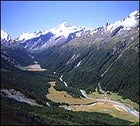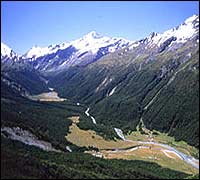It wasn’t exactly grand theft auto. I prefer to say that I borrowed the car that first carried me into Mackenzie Country. On the only occasion that I met him, I’d heard the owner, a friend of a friend, lament his inability to sell the wreck at any price, and say he wouldn’t mind if it just disappeared. When he went on vacation, it did. (Since I returned it after a few weeks, I figure there was no harm done.)
 Escapism 101: Mount Aspiring, Mount Aspiring National Park
Escapism 101: Mount Aspiring, Mount Aspiring National Park Once I’d remembered my father’s hot-wiring lessons it only took a spare battery, a set of points, and a few minutes to get the old jalopy┬Śa hunk of rusted English pig iron called a ’56 Salmon┬Śthundering down the road. Early one January morning in 1988 I found myself rolling south on Route 1 from Christchurch, free, stupid, 23, and slightly outlaw. The Salmon had no license plates, no proof of inspection, no registration, no muffler, and was running on two cylinders. I had no auto insurance and, soon enough, an expired tourist visa. No matter. To help push-start the car, I picked up every hitchhiker I saw┬ŚAussie rock climbers, Scottish peak-baggers, and Kiwi rafting guides eager to fling themselves from Queenstown bridges┬Śand rolled steadily south.
At Burke’s Pass in the Snowy Mountains, about 120 miles out, the exhaust manifold broke off. I crawled underneath the car and, using fencing wire, reattached it. Then I lay there, staring upside down at the horizon in awe.
I’d heard the locals speak of something called The Mackenzie, but no name is big enough for this vast terrain on the South Island, an upland basin of windswept tussock grass, where 50-milelong valleys collide at the horizon with wedding-cake glaciers. Turquoise creeks braid through the landscape, feeding immense lakes full of brown trout the size of my leg.
Few maps denote The Mackenzie, and those that do limit it to the Mackenzie Basin or the Mackenzie District┬Śa 100-mile swath across the South Island between the Southern Alps and the plains of Canterbury that’s home to just 4,077 people. But The Mackenzie of legend is broader than that, and encompasses 23 of New Zealand’s 25 highest peaks. It is a revered land of frozen gods and skies unsmudged by jet contrails, a dream of vanishing-point canyons, granite mountains, and waters of such unfathomable purity that I have twice tripped on streams I mistook for air.
To many Americans, this area┬Śthe Southland┬Śhas become known as a reverse-season wonderland of non-stop adventure┬Śthe beating heart of the “thrill-sport nation.” Indeed, adrenaline is bottled and sold here, whether to kayakers shooting the gold-flecked rivers of Central Otago or to bungee jumpers committing recreational suicide (the sport was first popularized in Queenstown). The truly masochistic come for New Zealand’s signature triathlon, the Coast to Coast, a connoisseur’s race pursued up streambeds, down rivers, and across the island in a single, inevitably bloody day. One of my 1988 hitchers went on to climb the Tasman Glacier; another scaled Mount Cook, the Kiwi Eiger and training ground of the young Edmund Hillary. A Scottish kid in a kilt (he said it helped him get rides) disappeared up the Copland Pass trailhead.
But you don’t have to push yourself to any extremes to appreciate The Mackenzie. You can just orbit in a jalopy, crash by the side of the road, take lazy day hikes up the valleys, and follow in the footsteps of the infamous James Mackenzie, the region’s pioneering fugitive.
I first heard about the outlaw one night in a dingy Twizel pub. I was demolishing Steinlagers with an ex-con who had teardrops tattooed on his eyelids. He owned a small, flimsy helicopter that he would fly into his own backcountry camp whenever things turned bad for him┬Śbankruptcy, say, or a divorce. He took a rifle for venison and a fishing rod for trout, and would not come out again until it was safe. He talked admiringly about this Mackenzie character, some kind of 19th-century rustler who had disappeared into the woods┬Ś”Gone bush,” my pub companion explained.
“He never came out?” I asked.
“Nobody knows, mate.”
Soon enough, I went bush myself. I began by climbing southward and up the famous Routeburn Track, a three- or four-day expedition above tree line. I walked along the ridges, soaking in the views, and eventually I came to a fork in the trail. One path led left, to that night’s hut, and then a road, and then the life I have led since. The other path led right, over an endless chain of hills, into the vast Fiordland National Park, New Zealand’s largest: approximately 7,200 square miles of primeval rainforest and granite peaks, a trackless wilderness cut only by 14 fjords whose most frequent visitors are dolphins from the Tasman Sea. Because the Southern Hemisphere has much less air pollution than the Northern, I could see far across those mountains, almost farther than I could stand.
According to the indigenous Maori, who discovered New Zealand five centuries before the Europeans, this terrain was literally divine. The South Island was formed, they say, when a canoe full of 150 gods foundered on a reef. The boat settled, creating the island, while the gods, climbing higher to avoid drowning, were frozen in place by the rays of the sun, thus creating the region’s 150 mightiest peaks.
I studied this possibility for a long time, until it seemed quite plausible, and then I turned left. I marched on, yet knew even then that I would never recover from that glimpse over the horizon, that vision of an inexhaustible world. And I knew I’d be back.
An obelisk marks the probable scene of the crime┬Śnot grand theft auto, but, allegedly, grand theft sheep. It’s about two-thirds of the way up Mackenzie Pass, which is itself some 20 miles down a gravel road from Route 8, the only paved road through Mackenzie Country. The modest memorial was once covered with lichen, but a distant clansman of the accused went and scraped clean the three sides of the marker, which are carved respectively in English, Maori, and Gaelic. The English side reads:
IN THIS SPOT JAMES MACKENZIE THE FREEBOOTER WAS CAPTURED BY JOHN SIDEBOTTOM AND THE MAORIS TAIKO AND SEVENTEEN AND ESCAPED FROM THEM THE SAME NIGHT 4TH MARCH 1855.
Believing as I do that you can go home again, at least briefly, I returned to The Mackenzie last year┬Śdriving a rental, thank you┬Śto go deep one more time. As Mackenzie’s questionable example had long been on my mind, I made a point of reading up on his exploits and made the obelisk my first stop.
An inspiration to generations of wilderness-loving Kiwis, Mackenzie was born in Scotland and arrived in New Zealand in 1850. According to a fellow Scottish crofter (who in the 1890s told a younger shepherd, who in turn wrote all this down in the 1940s), Mackenzie was six feet tall, muscular but thin, and known for claiming (when convenient) to understand only Gaelic.
Mackenzie was respected then as now for one thing: He went bush like no one has ever gone bush. The Maori were fierce warriors who had only just ceased active warfare against the British, and the colonials were still too afraid of the unknown interior to venture there. Mackenzie was not. During the early 1850s he repeatedly crossed over the mountains and disappeared for months at a time, exploring and living off the land. Only his dog, Friday, would accompany him. By 1855 colonists on the coast were calling the interior “Mackenzie’s Country,” a name that stuck even when Mackenzie’s reputation went south, too.
It turned out that wherever Mackenzie passed, sheep disappeared. In those days cattle rustling was virtually the Celtic national sport, and Mackenzie had trained Friday to lead the stolen mobs over a new pass he had discovered (and which now bears his name). Meanwhile, the Highlander would walk a different route, ready to claim he knew nothing about any stolen cars┬ŚI mean, animals.
John Sidebottom and those two Maori shepherds with the odd names finally caught Mackenzie red-handed one rainy March day in 1855. As the story goes, they tied him up and left him on the ground. But by the time they finished rounding up the “borrowed” sheep, they returned to find their prisoner gone. Legend has it that Friday chewed through his master’s ropes.
Later, Mackenzie was captured again. He was bound, this time with chains, but as they led Mackenzie toward jail he made a break for it anyway. He only got a few hundred yards before gunfire cut his legs out from under him. The wounds proved superficial, however, and he escaped again a short time later.
Escape, in other words, is the point of the place. And today, it still offers territory as free and empty as any escape artist could desire.
On my recent return trip, I drove 40 miles up a gravel track into a valley of the Godley Peaks, and then another 12 miles along mountain faces in a farmer’s “ute,” the flatbed truck that gives this rugged nation its mobility. In view was Lake Tekapo, colored an unbearable powder-blue by glacial runoff, and as long as the loose shale under our tires held us to the mountain slopes, I remained happy. Once in a while my driver, a lonely 24-year-old, would stop the car, stare at the ridge line. “God musta been a photographer, eh?” he said.
I dropped my backpack in a hut built in 1920 for a shepherd named Sutherland. From there I hiked into the realm of Maori deities who came for their own glimpse of the unlimited and never left. Alone in an immense, perfectly flat valley backing onto Mount Cook National Park, I played fugitive, spending my days stalking the brown trout that floated dead-center in the streams, arrogant and regal, unshadowed by man. By night I fumbled with the woodstove, counted unfamiliar constellations, and wondered what became of New Zealand’s own Billy the Kid, whose Gaelic name, it turns out, was Seumas Mac Coinnich.
His legend ends abruptly. Despite two successful and two failed escapes, Mackenzie was finally convicted in Christchurch and sentenced to hard labor. Amazingly, popular opinion was on his side. Kiwis are a frontier people who admire those who can make do with a good dog. In the end, Mac Coinnich vanished one last time. He was pardoned by a governor who admired his brio. The governor simply required that he leave the country, and with that the record falls silent. The shepherds who knew him said that Mackenzie’s one unrequited dream had been to visit America. I’d like to think he lived that dream, that he took a ship into exile and brought his unruly passion for freedom to us. But I don’t believe it.
I have seen the view from Mackenzie Pass, and I think I know which way he went.
Whether you want to investigate the haunts of a legendary sheeplifter or simply camp out in some of the most pristine backcountry on earth, here’s a few things you’ll want to know.
When to Go:
New Zealand’s seasons are opposite to North America’s. The best weather is from January through March, though most trails can be hiked anytime from November to April.
Getting Primed:
New Zealand is well promoted on the Web. Here are three sites worth checking out: www.purenz.com (the official site of the New Zealand Tourist Board), www.mtcook.org.nz (a site devoted to Mount Cook and the Mackenzie District), and www.doc.govt.nz (the best site for info on backcountry travel). For historical background, hunt down the out-of-print book Mackenzie of the Mackenzie Country by James Herries Beattie (Cadsonbury Publications, 1946).
Getting There:
Christchurch is the jumping-off point for The Mackenzie and all spots south. The connecting flights from Auckland stop here. Auckland is served by Air New Zealand, Qantas, and United. Round-trip high season fares from Los Angeles range from $1,540 to $3,380.
Staying There:
Tiny, windswept Twizel offers accommodations rude and refined. For my base camp, I chose a delightfully retro A-frame at Mountain Chalets ($45 per person per night; 011-03-435-0785). Backpackers with their own linen can get by for as a little as $15. If you can afford even one night at the more upscale Hermitage ($105┬ľ$285; 435-1809), the views of Mount Cook are worth it. Down in Queenstown, my B&B of choice is the Queenstown House ($165┬ľ$185; 442-9043).
Eating Out:
Fairlie, the wee capital of the Mackenzie District, boasts the Old Liberty Cafe, famous, not surprisingly, for its lamb and venison. Lamb for two will set you back $40. Like Bill Clinton, I dined at Queenstown’s lovely Boardwalk Seafood Restaurant & Bar (dinner for two, $75; 442-5630).
Outfitters:
For weather reports and climbing guides in the Mount Cook area, try the Glenntanner Park Centre (435-1855). In the Mount Cook village, Alpine Guides (435-1834) rent virtually all climbing equipment. Mount Cook Ski Planes (435-1026) run airlifts to the top of Mount Cook. Adult fare is $225.


